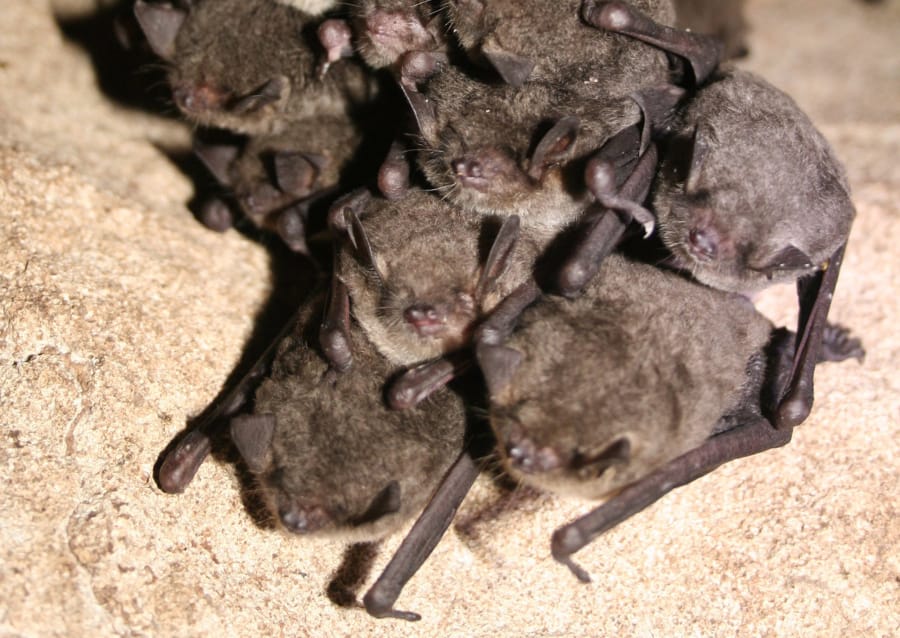ST. LOUIS — Whether it’s ice, lake-bottom mud, or cave stalactites and stalagmites, if something piles up and accumulates over time, it can tell scientists about past climate conditions or surrounding landscapes and how they’ve changed.
That’s also true for big, old, slippery piles of bat poop, or guano, from Missouri caves. The material is the focus of an ongoing study by researchers from Washington University, the Missouri Botanical Garden and Virginia Tech.
It makes for a messy medium.
“You definitely want to wear rubber boots,” said Christy Edwards, a conservation geneticist at the Missouri Botanical Garden who is helping lead the study and analysis. “You need to wear a mask. It’s pretty stinky. It’s dark. It’s not the most pleasant field environment.”
But the payout could be worth it. Where some might see a giant, brown, squishy heap of guano, Edwards and colleagues see what could amount to centuries or millennia of localized natural history records buried within generations of bat diets, layered on top of one another. They just need to scoop it up.
“You’ve got insects flying around eating plants and then the bats flying around eating the insects,” explained Rachel Reid, a research scientist in the geoscience department at Virginia Tech who began work on the project as a postdoctoral researcher at Washington University. “The guano is ultimately going to be recording back down to that base of the food chain, and what plants are available.”
In other words, changes in the composition of the bat droppings can reflect how vegetation has transformed over time in the surrounding area.
“Bats, they’ll fly 30 or 40 miles, so that’s the snapshot we can get,” said Edwards. “There’s changes in diet over time. And we’re essentially using that as a proxy for changes in the environment.”
The team gathered cores of guano in the fall of 2018 from Mary Lawson Cave near Lebanon, Mo. — extracting samples that reached about two feet down, through the pile. Sections of the cores can be analyzed for different carbon and nitrogen readings to identify changing trends over time. To better understand the old layers of bat poop, modern guano samples from the cave’s population of gray bats were also gathered this summer for comparison, using tarps placed in front of the entrance.
All that analysis is continuing, leaving main questions unanswered for now — including how far back in time the guano record from that spot extends. That will be a key to understanding whatever changes are reflected within the cores.
“Obviously the last couple hundred years would be reflecting shifts in agriculture and land-use changes,” said Edwards. “Over a longer period of time, you could get a look at climate.”
Different carbon signatures, for instance, can reveal certain characteristics about the types of surrounding vegetation. And nitrogen readings can potentially reveal things such as the amount of precipitation in an area, Reid said. Collectively, the group’s analysis can show how the land has changed over time.
“We can explore not just the natural history, but how humans have changed landscapes,” said Reid.
While the concept of gleaning “paleoclimate” records from deep cross-sections of bat guano may raise some eyebrows, the approach is not entirely novel. Reid said she is aware of guano studies done in places like Romania and the Philippines, and samples that have extended more than six feet deep and yielded records at least 18,000 years old.
This is also not the first time that guano core samples have been collected in Missouri. Similar work in Round Spring Cavern, near Eminence, collected a nearly 3-foot profile of guano that began to accumulate about 8,100 years ago, according to research published in 2010 by scientists from the University of Southern Mississippi. And an earlier study by a University of Wisconsin researcher plucked an approximately 2,800-year-old guano core from Tumbling Creek Cave, near Protem.
Each of those previous Missouri studies examined guano’s usefulness as a record for airborne dust and pollen from various plant species throughout history.



